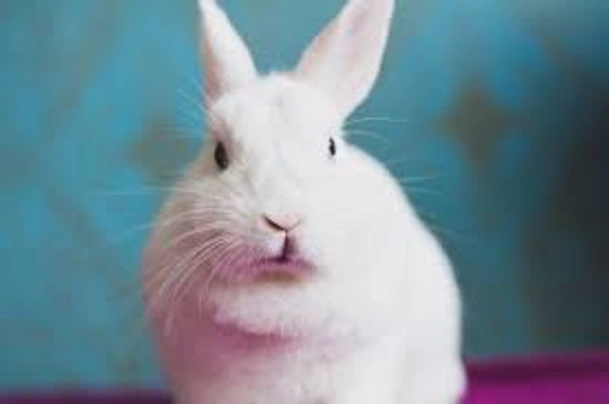Hulstlander
Introduction of the Hulstlander
This snowy white bunny is sometimes referred to as the Hussie and was developed in Holland in the late 1970s. The pure white Hussie boasts pale blue eyes and is small, usually weighing in at around 5.5lb.
Although the Hulstlander is a relatively new breed of rabbit, it quickly became a firm favourite with fanciers and are regulars at shows across the world. They’re known for being playful and inquisitive and can also be very cheeky.
History of the Hulstlander
The Hulstlander was originally bred in the Netherlands in 1977 by Mr J de Graaf, who wanted to achieve a small, pure white rabbit with pale blue eyes. In order to achieve the Hulstlander we see today, Mr de Graaf put a Polish rabbit with a Vienna White, although some experts believe it was a Blue Eyed White rather than a Vienna.
So impressed with the resulting animals was Mr de Graaf, that he began campaigning and lobbying the rabbit clubs in order to make the Hulstlander, that was named after the area of Holland from which it originated, a recognised breed.
Appearance of the Hulstlander
- Main colourways: pure white with blue eyes
- Average weight: 2.5 kg
This is a stunningly beautiful rabbit with pure white fur and striking blue eyes. They are a small to medium breed that’s quite thick set, with broad shoulders, displaying a build commonly referred to as ‘cobby’. The Hulstlander Rabbit has a wide head that’s more noticeable in bucks than does.
They have large, thick ears that are held in a ‘v’ shape and are well covered with fur. The coat is very dense and is a lustrous white with a thick undercoat and short guard hairs that seem to lend the coat a sparkling sheen. Unusually for a pure white rabbit, the eyes are an arresting blue colour, rather than pink.
Temperament of the Hulstlander
The Hulstlander is known for being inquisitive, playful and confident. They’re also very intelligent and are therefore very quick learners. They are eager explorers and will enjoy time outdoors in a run or a secure area of garden and their confidence can also mean they can be very cheeky.
As with all rabbits, the Hulstlander can be skittish, despite its confidence and laid-back demeanour. If they feel vulnerable, stressed or uncomfortable they can panic and make for the nearest hiding place. This isn’t ideal if the animal is being held, as they are very strong for their size and can easily cause themselves or their handler injury as they try to escape.
Health of the Hulstlander
As a hybrid animal, the Hulstlander is generally healthy, but there are conditions that can affect all rabbits that owners should be aware of. All rabbits should be treated regularly for fleas, ticks and worms and they should also be vaccinated against the highly infectious Viral Haemorrhagic Disease and myxomatosis, both of which can be passed on to pet rabbits by wild animals.
The teeth of all rabbits should be checked regularly to ensure they’re not too long. Rodents’ teeth grow continually and can cause injuries in the mouth and difficulty with eating if they’re allowed to get too long. Overgrown molars and enamel spurs should be treated by a vet.
Diet can also play a part in keeping teeth worn down. Rabbits should be fed a high-fibre diet that contains good hey, pellets and plenty of fibrous vegetables such as cabbage, kale and dandelions, all of which will help to keep his teeth in check. His diet should be managed carefully and he should not be allowed to get overweight. Plump animals have difficulty grooming and can be susceptible to flystrike, where flies, attracted to soiled areas of fur, lay their eggs in the coat and the resulting maggots burrow into the skin, causing pain and open wounds.
Non-breeding females should also be spayed in order to prevent uterine cancer, which is common in rabbits.
Caring for the Hulstlander
Before you bring your rabbit home it’s important to decide whether he’s going to live indoors or outdoors. If he’s going to be a house rabbit he needs to be taught to use a litter tray and he should also have access to a cage or crate where he can go to completely relax. Cables and wires should be kept out of his way and he should also have access to the outdoors regularly so he can indulge his love of exploration.
If he’s going to live outdoors his hutch should be weatherproof and large enough to allow him to hop around and stand on his hind legs. It should be placed out of direct sunlight and wind and if it can be placed in a light, airy shed this is ideal. The hutch must be lined with shavings and straw and cleaned out thoroughly once a week. Droppings should be removed daily.
The hutch should have a covered area where he can nest, and providing boxed and tubes for him to climb on and hide in will be very much appreciated. Gnaw toys and cat or dog toys will also help keep him occupied.
His diet should consist of good quality hay and pellets, as well as green leaves and vegetables including carrot tops, kale, cabbage and dandelion leaves and he should have access to fresh, clean drinking water at all times.
